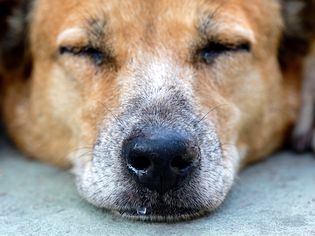Folliculitis is a skin condition that commonly affects dogs. Irritation of a hair follicle causes inflammation in the area, leading to swelling, redness, itchiness, pain, and other skin lesions. Although there are no dog breeds genetically predisposed to folliculitis, dogs prone to allergies are at a greater risk of developing this condition. It has a variety of causes, all of which require veterinary treatment.
What Is Folliculitis?
Folliculitis is a term used to describe the inflammation of a hair follicle that typically involves a bacterial infection. Hair follicles are tiny openings in the skin through which hair grows. In folliculitis, one or more follicles become irritated or infected, causing inflammation in the area.
Symptoms of Folliculitis in Dogs
Dogs with folliculitis may have one or more skin lesions on the body. It may start as a small raised area on the skin that looks like acne (called a papule). The area may become more raised and fill with pus (called a pustule).
Folliculitis may cause itching, pain, redness, and hair loss (alopecia) that has a patchy appearance on one or more areas of the dog's body. Some dogs develop crusty or flaky round skin lesions called epidermal collarettes. Hyperpigmentation (dark spots on the skin) may also occur in affected areas of the skin.
Causes of Folliculitis
Folliculitis in dogs is caused by irritation of one or more hair follicles by one of the following conditions:
- Bacterial infection (often Staphylococcus bacteria)
- Fungal infections (such as ringworm)
- Parasites (fleas, ticks, or mites)
- Trauma to the skin or hair
- Systemic diseases (thyroid abnormalities or immune dysfunction)
Diagnosing Folliculitis in Dogs
Contact your veterinarian if you think your dog has folliculitis or any skin irritation of unknown cause. After assessing information about your dog's signs and history, your vet will do a physical examination and may be able to diagnose folliculitis by visual inspection. However, further testing is often necessary to determine the exact cause. Potential testing includes the following:
- Skin cytology to examine cells under a microscope
- Skin scrape to check for parasites like mites
- Skin biopsy, where tiny samples of the skin are removed surgically and sent to a pathologist for detailed analysis
- Fungal or bacterial cultures
- Blood work and urinalysis to assess organ function and blood cell counts
Treatment
The treatment of folliculitis in dogs is determined by the cause. Therapy typically involves a combination of systemic medications and topical applications like sprays, creams, ointments, and shampoos.
Topical treatments are used in most cases to ease discomfort and reduce inflammation. Your vet may recommend regular baths with a medicated shampoo. Sprays, creams, or ointments containing steroids, antibiotics, or antifungal agents are often necessary as well.
Bacterial folliculitis is usually treated with oral antibiotics. A long course of treatment may be necessary to eradicate the bacteria. Fungal folliculitis requires antifungal medications. Certain types of fungal infections require long-term treatment as well.
Parasitic infections require medication to kill the parasites as well as supportive care to promote healing. Antibiotics may still be prescribed to treat a secondary infection.
If the folliculitis is caused by a systemic disease, then that disease must be treated in addition to the skin inflammation. Depending on the disease, long-term or lifelong treatments may be necessary.
Prognosis for Dogs with Folliculitis
The prognosis varies based on the cause of the condition. Folliculits due to localized infection or irritation usually responds well to topical treatment and oral medications, and dogs recover within a couple of weeks. If the folliculitis is caused by an underlying systemic health issue, the dog's prognosis depends on the severity of that condition and how well the dog responds to targeted treatments.
How to Prevent Folliculitis
Folliculitis in dogs cannot always be prevented. Early detection and treatment are the best ways to keep folliculitis from getting worse. Dog owners can take steps to prevent folliculitis by keeping systemic health issues like hypothyroidism under control with appropriate long-term medication. Be sure that you contact your veterinarian at the first sign of skin issues.








